Daryl Rich, D.C., C.S.C.S.[Core] Chiropractic and Wellness
CoreRoanoke.com

Could balance and flexibility be a predictor of your life’s longevity and cognitive abilities? New research says, YES! An article published in the European Journal of Preventive Cardiology linked life expectancy with the ability to rise from a seated position on the floor to a standing position. This study and several like it, have shown that sedentary lifestyles create stiffness and increase our mortality rate and rob us of our quality of life.
So, what changes in us as we age to cause us to lose flexibility and have poorer balance? And most importantly, is it reversible? Gil Hedley, PhD, demonstrates in his video, “The Fuzz Speech,” (http://www.youtube.com/watch?v=BdRqLrCF_Ys) how muscles gather “Fuzz.” Hedley’s “Fuzz” is scar tissue, a sticky, fibrous material that diminishes the sliding ability of muscles between themselves and the skin. This scar tissue is highly innervated, creating pain and discomfort when stretched or injured.
Hedley explains why it is important to stretch daily and be more active. Sedentary lifestyles coupled with inappropriate treatment of musculoskeletal injuries leads to this accumulation of “Fuzz” and decreased mobility. This has a profound effect on quality and quantity of life.
Better Balance Equals Better Brain Power
Have you ever asked yourself, “Does my ability to maintain healthy balance have anything to do with how well I think, remember, and solve problems?” Perhaps that exact thought, or anything close to it never actually crossed your mind, but it should. Assessment and treatment of impaired balance is being researched as a possible “Holy Grail” for higher level thinking by many experts in the brain world.
Our ability to stand on two legs is nothing short of remarkable. Becoming bipedal is possibly our greatest feat as human beings. Balancing on the stilts we call legs, requires a tremendous amount of brainpower. Walking is an even greater accomplishment! Walking is a state of constant falling requiring constant and precise input from the many sensory receptors located in our eyes, inner ears (vestibular system), muscles and joints (proprioceptive system). Any damage to these systems, or changes in our brain’s control over these systems, will lead to measurable changes in our ability to balance and walk. Think about this, when an individual’s brain is “offline” due to alcohol consumption, disease, or simply waking from a deep sleep, he or she has a dramatic increase in the likelihood of falling. How many more problems occur from less temporary cognitive damage seen with dementia and other neurodegenerative disorders?
The Connection Between Balance and Cognition
Now that you understand the very basic connections between the brain and our ability to maintain balance, you can begin to see why it is essential to maintain healthy balance. Bipedal locomotion (walking on two legs) has long been associated with our larger and more complex human brains. Over the past several decades, the research has been accumulating to support the fact that our ability to move through our environment (spatial navigation) is directly related to our ability to learn and remember. A groundbreaking paper published in the Journal of Vestibular Research, demonstrates that the degree of damage to the vestibular system is directly correlated to changes in the hippocampus, which is a key component of memory and higher cognitive function.
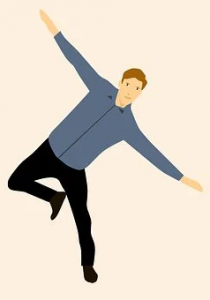
A more recent paper published in the journal Stroke, discusses the irrefutable link between poor balance, cognitive decline, and small blood vessel disease in the brain. Subjects that had a reduced ability to stand on one leg were clearly shown to have lower cognitive functions of memory and spatial awareness. The lead author of this study urged that those with postural instability (impaired balance) should receive special attention as they may be at greater risk of cognitive decline.
Many cognitive researchers now agree that the simple neurological observation of a patient’s ability to “rise, stand and walk” is “the single most important part of the entire neurologic examination.”
Test Yourself!
Did you know that if you are under the age of 65 and cannot stand on one leg for over 90 seconds that your probability of developing dementia increases by nearly 40%? Those who can stand for 90 seconds show an even less chance of developing dementia if they can stand on one leg with their eyes closed for over 15 seconds! This easy test may be one of the best predictors of future mental health than any scan or blood test.
What to Do if You Are Having Balance Problems?
Fix it! You can improve your balance by exercising the brain and body. Perform these simple exercises twice a day and see your balance improve and your brainpower strengthen.
Here are some daily movements that can help reduce your “Fuzz” and keep your muscles subtle and flexible.
The Good Morning Stretch
- Start with your feet shoulder width apart and your hands at your sides.
- Bend your knees to a slight squat while performing a scooping action with both arms. This would be similar to scooping water out of a bucket between your legs.
- Straighten to a standing position with palms to the sky.
- Now lace fingers together and stretch to the sky.
- Lean to each side gently allowing for a slight stretch down the flank and into the hips.
- Return to the starting position and repeat five times.
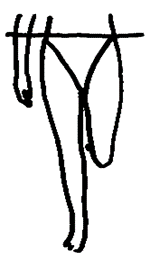
One Leg Stance
- Stand on one leg without your other leg touching the ground or any other part of the body.
- Keep your eyes up off of the floor. If you need assistance, hold lightly onto a chair or doorframe.
- Stand for 30-60 seconds in this position.
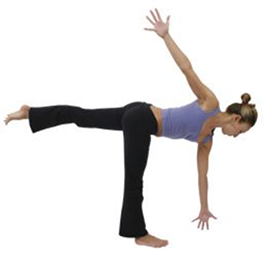
One Leg Airplane
- Stand on one leg.
- Tip forward while keeping a good neutral lumbar curve.
- Extend your arms out to the side.
- Slowly rotate your pelvis from side to side as far as you can without falling.
- Try to keep your eyes on the horizon and not on the floor.
- Repeat for each hip in 30 second intervals.
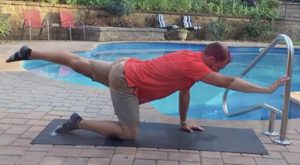 Bird-Dog
Bird-Dog
- On hands and knees, begin by raising one hand and replace it on the floor.
- Raise a leg and replace it on the floor.
- If you are able to keep your spine stable during the beginner version of the exercise, then raise opposite arm and leg with a stable spine.
- Repeat by alternating arms and legs, perform for 30-60 seconds.
- You can find this exercise on our YouTube channel (CoreRoanoke) by following this link. https://youtu.be/rPL5y2HqFsY
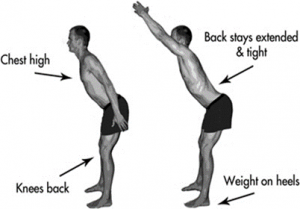 Founder
Founder
- With your feet wide apart, bend at the waist keeping your weight into your heels.
- Bend your knees slightly with your hands at your side by your hips. Take a deep breath and hold this position for 15 seconds.
- Now slowly take your hands overhead and hold again for 30 seconds.
- Repeat 2-3 times.

Daryl C. Rich, D.C., C.S.C.S.





